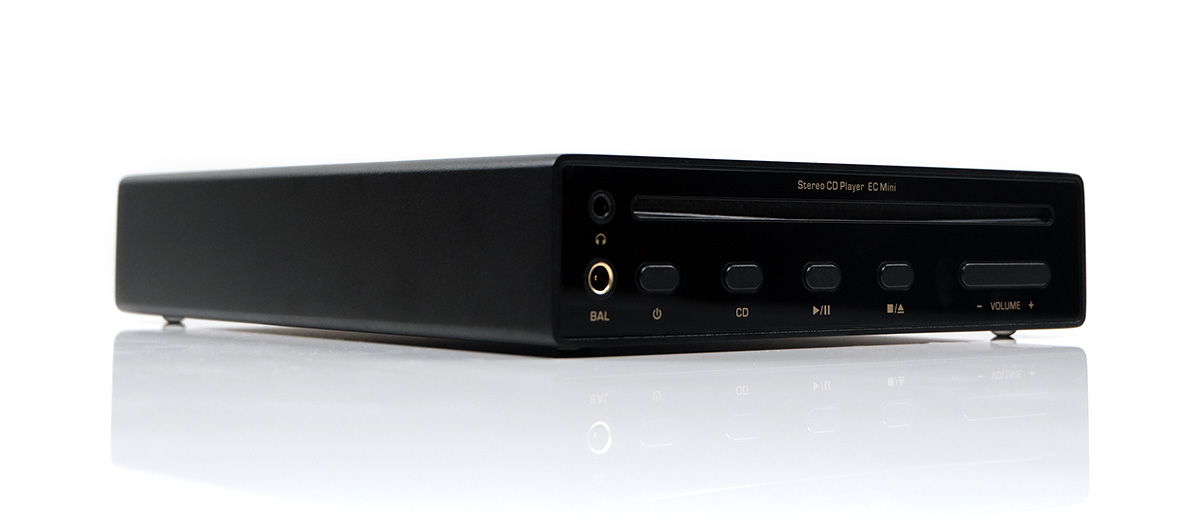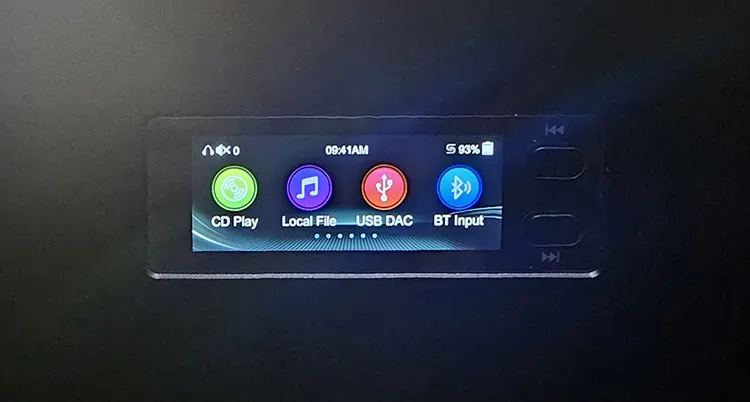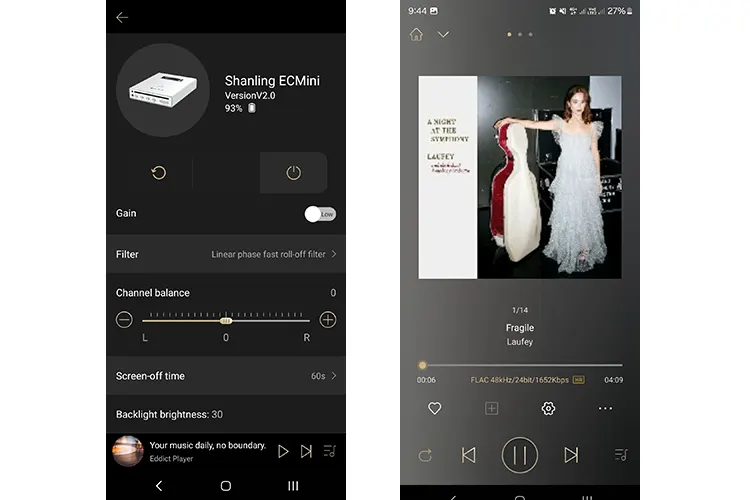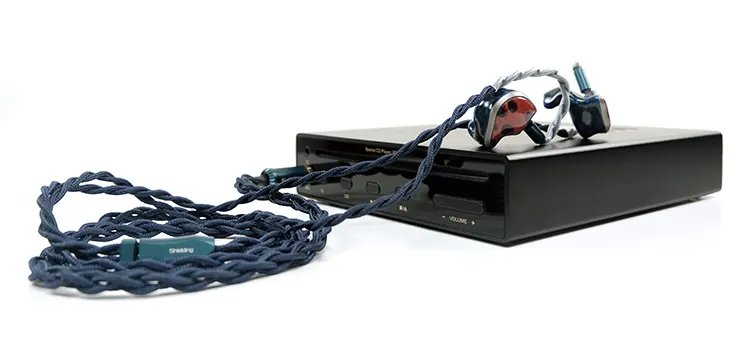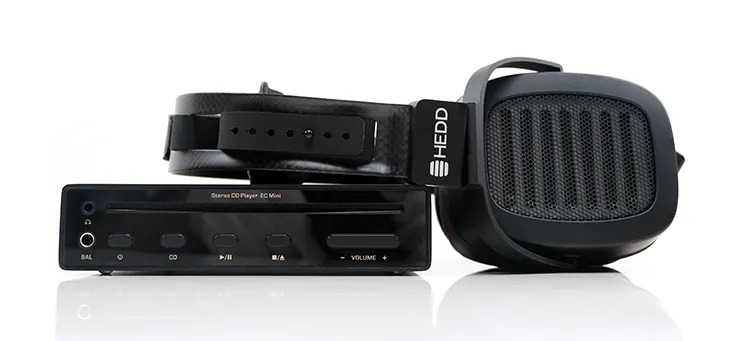Software Impressions
The current firmware of our evaluated Shanling EC Mini sample is V2.0. You can upgrade your unit by downloading the files from the main Shanling website support section and installing them to the player via a microSD card.
The Shanling EC Mini’s GUI layer is powered by an Ingenic X1000 chipset which is also the bedrock for their lower-tier MTouch DAPs such as the M0 Pro. If you have an M0 Pro a lot of the design cues between the two devices are quite similar.
This is not an Android framework so there is no app expansion or WiFi connectivity similar to what you will find on the higher-end DAPs or the EM5 streamer.
You can, however, SyncLink with the Eddict app from a smartphone or iOS (iPhone) using built-in BT which will give you a measure of media control from a familiar Android environment.
Navigation
From the EC Mini home screen, you have 6 icon options. The first four are playback output modes including the CD player, local digital media playback, USB-DAC, and BT. Beyond that, you have playback and general setting features.
The navigation is gesture-based with a downward stroke allowing you to access some shortcuts similar to an Android drop-down icon system.
Here, you can quickly switch between headphone or pre-out mode, opt for single or dual-DAC use, choose between low or high gain, or adjust your playback options.
A sideswipe from the left will bring you back to the main options menu screen and from there you can navigate between the main menu options by swiping left or right from either edge of the screen.
For options such as local media, the main screen switches to a more typical top-down scrolling navigation to allow you to go through the various options with each label being clickable.
Media Management
You also get a similar experience for local file media management with the EC Mini scrollable navigation and drill-down clickable media labels. Artwork will display as a thumbnail on the screen and in Eddict if you have a jpg file in the root of the folder holding the album files.
You do not have a huge amount of vertical viewing real estate with the EC Mini LCD screen so if you have huge media libraries then I would recommend navigating and controlling playback via the Eddict app on your phone which is by far the more user-friendly of the two methods.
Unfortunately, there is no artwork or CD Text-enabled capability on the EC Mini when playing CDs. A swipe left will give you the ability to navigate through the tracks but they will show track number WAV files only.
Playback Management
The playback submenu options are quite in-depth with everything from H/L gain modes, filters, and a built-in customizable EQ system to replay gain, channel balancing, and a gapless playback option.
One thing I did notice is gapless playback for CDs is not quite as gapless as I would have liked with a small gap between tracks. It only really crops up for me on live albums or DJ continuous mixes but if you are very demanding for your gapless quality the EC Mini is not as refined for this as some higher-end CD players.
The EQ options offer 8 presets and an additional 3 storable customizable options with the jazz and metal presets my current favorites. The rest either sounded overly veiled, lacking in air, or too amplified causing noticeable distortion with some IEMs.
There is no noticeable attenuation either in volume levels when switching the EQ system on or off which can often be a criticism of EQ systems on other platforms.
Settings
The general settings menu is more about your environmental controls including battery management options such as sleep, idle, and screen brightness options.
From here you can also update the EC Mini firmware via a local file loaded onto a MicroSD card. Having done the update myself to V2.0 it’s quite seamless and takes just a few seconds to update.
Bluetooth options are also adjustable from the settings menu. I would suggest leaving this on along with the SyncLink option on the same screen even if it reduces your battery life as it allows for a quick hookup with Eddict or a wireless headset without having to drill down to find the settings every time.
One final thing to note in the BT settings is the quality menu which allows you to set the default code level for wireless connections. It ranges from SBC right up to LDAC with LDAC set as the default. You can go one step further though and set sound quality as a priority over signal stability with LDAC HQ.
Sound Impressions
Setup
The following sound impressions of the Shanling EC Mini were completed using the Campfire Audio Fathom and Unique Melody’s Multiverse Mentor for my IEM choices. I used a mix of HEDD Audio HEDDphone Two and the Audeze MM-500 for my headphone choices.
For the CD Performance, regular 16BIT/44.1K CDs were used along with lossless FLAC for the local microSD playback. The same lossless FLAC tracks were fed via a PC for the USB-DAC performance (Roon).
Summary
Overall, the EC Mini projects a slightly warmish, bottom-weighted, yet relaxed sound signature. It has a similar tone regardless of the output format but there are some variations on the technical side between its single-ended and balanced output which I will get into further down in this summary.
I have seen the EC Mini described as slightly dark in its overall tuning and it’s heading in that direction. However, unless you pair it with an already dark-sounding headphone it still delivers decent headroom and treble extension.
Rather, it’s not an edgy set of highs nor as neutral/bright and lean as something like the ES9018K2M-equipped Mini-CD MK2 from Cayin. It is also not as aggressive sounding as the desktop equivalent, the CD80 whose default gain level seems a shade higher.
It gels very nicely with energetic V-shaped gear if your objective is to bring a bit of calm to the highs and does exceptionally well with vocal forward head gear where sibilance or disconcerting 3rd-order harmonics might be a problem.
I must clarify that for bottom weighted it is more the EC Mini’s lower mids having a fuller, richer sound compared to the bigger CD80/CA80’s punchier sound even though both have the same amplification for their respect 3.5mm headphone outputs.
An important difference between the EC Mini’s SE and balanced output is their respective levels of energy and dynamics. The balanced performance sounds more accurate to my ear with better separation, improved dynamics, and headroom.
The SE sounds noticeably softer, both for slam and attack with a reduced level of staging depth and treble presence. However, the vocal texture seems more alluring compared to the balanced output performance.
Gain Coloration
This is more about the influence of the gain settings on the EC Mini than simply describing the general coloration. Shifting through the gain levels in either unbalanced or balanced format seems to have a noticeable effect on the midrange and treble coloration.
On low gain SE using the Fathom as the test IEM, the treble influence is mild with just a gentle sheen giving it a slightly sweet overtone which I enjoyed a lot for higher-register vocal performances.
Once you switch to the balanced output then the treble stiffens a little and grows more influential. On the low gain setting this results in a more accurate tonal balance on the lows of the Fathom and a slightly more sibilant overtone on the vocals.
Overall, this remains my preferred output for the additional energy the treble brings to the performance but it is not quite as intoxicating for vocals as the EC Mini’s SE low gain output.
On the high gain balanced output, I felt the Fathom’s upper treble presence was more stressed sounding with sharper edges to the upper mids and more of a shrill higher register vocal quality. For IEMs that are sensitive to treble presence, I would avoid the high gain here for both outputs.
Wireless Performance
The LDAC BT performance from the EC Mini is acceptable without being mind-blowing. It has this slight softness again with a reduction in dynamic range and instrumental/vocal separation from the staging performance.
It’s a bit like going from balanced to unbalanced in wired mode with the mid-bass punch loosening up a bit and the treble losing a bit of body and incisiveness. The TLDR is a bit polite-sounding compared to wired mode.
Synergy
Noise Floor
The Shanling EC Mini’s headphone amplifier is rated at 240mW balanced and 140mW unbalanced on a 32Ω load. That’s just enough power for more efficient headphones though I felt it was a more natural home for in-ear monitors with its excellent low-noise performance and black background.
I saw a more natural home in the context of the EC Mini’s sibling desktop players, the CA80/CD80. Both of these larger players use the same headphone amplifier and DAC as the EC Mini with a similar single-ended performance rating of 140mW under a 32Ω load.
And yet, the noise floor is a shade higher which suggests Shanling has refined the EC Mini’s gain levels to be more IEM-friendly compared to the desktop units. That is even before we start talking about the fact the EC Mini has a low and high gain feature which neither of the bigger players offers.
A good example is the recently reviewed Campfire Audio Fathom which is a fairly sensitive all-BA IEM. On both the SE and balanced outputs, any potential for noise was low with barely any background hiss and a nice gradual increase in volume from zero onwards rather than an abrupt introduction from step 1.
As a bonus, both outputs of the EC Mini are less than 1Ω so there is not much of a chance for impedance skew with the Fathom pairing, and channel balancing on both outputs is quite solid on low volume.
IEM Pairings
I tested four very different IEMs with the EC Mini including the new Campfire Audio Fathom and their planar driver Supermoon, the JH Audio Jolene, and FiR Audio Radon 6.
In most instances, I went with the EC Mini’s low gain setting for more sensitive IEMs like the Fathom.
The SE output also allows you to activate the EC Mini dual DAC mode which I prefer for detail-orientated IEMs. You get a little lift in resolution and nuanced detail without losing that smooth performance that suits Fathom’s balanced tuning to a tee.
For more demanding IEMs such as the Campfire Audio Supermoon, I switched to high gain via the EC Mini’s balanced output which sounded much livelier, more immersive, and dynamic on the lows.
That goes double with the JH Audio Jolene which sounded too soft on the lows and lacking in midrange air from the EC Mini’s single-ended output.
The low-end separation and layering were more convincing when using the balanced output. The balanced output also delivered additional treble presence for improved clarity and a better harmonic balance for percussion timbre and electric guitar chords.
For the Radon 6, I would keep it low gain but use balanced only. Going single-ended was again a bit too soft and polite with less definition and a lack of urgency on the lows for my liking.
Switching to the EC Mini’s balanced output injected a much more bombastic and impactful delivery from the Radon 6. I would not advise going balanced high gain with this pairing as the treble starts sounding too strained and energetic, upsetting the overall balance of the pairing’s performance.
Power
Easy-to-drive headphones like the Meze Audio Empyrean II and the Audeze MM-500 had no issues going balanced high gain on the EC Mini with plenty of volume headroom. The Elite required less than 50% volume on a balanced output connection and the MM-500 was about 1-2 steps less volume than the Elite.
Your only question with these types of headphone pairings will be whether the EC Mini’s balanced output will deliver a good enough dynamic range match with the EC Mini compared to more powerful amplifiers.
Headphone Pairings
I tested 3 headphones via both the PO and LO outputs connected to a dedicated Xi Audio Formula S single-ended headphone amplifier. These included the Audeze MM-500, the Meze Audio Empyrean II, and the HEDD Audio HEDDphone Two.
The MM-500 got my vote in terms of ideal coloration and imaging. The MM-500 is quite mid-forward and can sound bright with some neutral sources. The smoother relaxed tonal quality of the EC Mini kept some of the MM-500’s upper-midrange energy nicely in check.
It has a relatively intimate staging quality, that’s the MM-500 for you and the EC Mini will not pull out too many shape-changing miracles.
However, if you are a vocal enthusiast the richer warmer tones of the EC Mini gel nicely with the MM-500’s prominent vocal imaging. Any distracting sibilance is also a rarity with this combo with a liquid treble performance rather than a sharp and spikey overtone.
Via the LO to the Formula S amp, the HEDDphone Two was less convincing. Here, I felt the EC Mini’s SE performance and drop to single DAC decoding came into play a bit more with a softer-sounding performance, reduced dynamics, and a flatter soundstage from the HEDDphones Two.
This would be a pairing I would be going into the EC Mini’s custom EQ for just to get a little more 8-10k presence out of the pairing.
On the other hand, the Meze Empyrean II’s more V-shaped tuning and feistier upper-mids are a much better pairing with the EC Mini. The cleaner highs and weightier lows sounded more natural and bombastic with the EC Mini compared to the more mids-focused HEDDphone Two.




